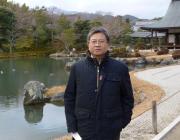Citation:

摘要:
Chongqing, the largest megacity in southwest China, faces serious aerosol pollution but lacks information on particle characteristics and its sources. Official data released by Chongqing Environmental Protection Bureau demonstrated that urban PM10 concentrations decreased remarkably from 150 μg m− 3 in 2000 to 90 μg m− 3 in 2012. However, only several peer-reviewed studies paid attention to local fine particle (PM2.5) pollution. In the study, PM2.5 samples were obtained and subjected to chemical analysis in an urban site of the city during 2012 to 2013. The annual mean PM10 and PM2.5 concentrations in urban Chongqing were 103.9 ± 52.5 and 75.4 ± 42.2 μg m− 3, respectively. PM2.5 showed a distinct seasonality of high concentration in winter and similar levels in other seasons. The average OC/EC (organic carbon/element carbon) ratio was 3.7 with more high-OC/EC ratio sources contribution in autumn and winter. The varying sources and formation mechanisms resulted in SO42 − and NH4+ peaks in both summer and winter, whereas high nitrate concentration was only observed in winter. In the average mass closure, PM2.5 was composed of 23.0% SO42 −, 11.7% NO3−, 10.9% NH4+, 30.8% OM (organic matter), 5.2% EC, 8.2% mineral dust, 0.6% TEO (trace elements), 1.0% Cl− and 1.1% K+, while exhibiting large seasonal variability. Using positive matrix factorization (PMF), six sources were apportioned in PM2.5: secondary inorganic aerosols, coal combustion, other industrial pollution, soil dust, vehicular emission, and metallurgical industry. The annual mean contribution of above sources to PM2.5 was 37.5, 22.0, 17.5, 11.0, 9.8 and 2.2%, respectively. Coal combustion was identified by As tracer and dominated the primary sources of PM2.5, while the two different industrial sources were characterized by Cr and Mo, Co, Ni, and Se, respectively. The study is of great importance in characterizing the historical trends, current chemical characteristics and sources of fine particles in urban Chongqing.
